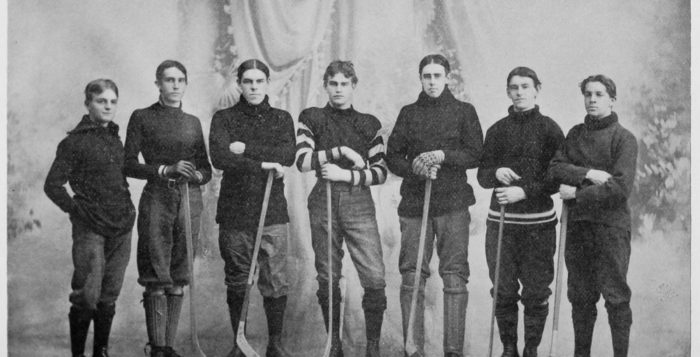This Day in Hockey History – January 19, 1898 – Inaugural Intercollegiate on Ice
(Photo: Brown University 1897-98, via Wikimedia Commons)
New England has a strong college hockey tradition that dates back to at least January 19, 1898. After a few years of switching over from ice polo and learning the Canadian style of hockey, some of the area universities had managed to put together teams and set up their first season of intercollegiate play. The opening game was held in Boston matching up Harvard College of Cambridge, Massachusetts and Brown University of Providence, Rhode Island.
Collegiate hockey in the U.S. can trace its beginnings back to Malcolm G. Chace who attended Brown (and then Yale) and Robert Duffield Wrenn of Harvard. Back in 1892, Chace realized the ice polo the Americans played was almost the same game as the hockey Canadians played. As a freshman at Brown, he took a trip north with Wrenn, then a junior at Harvard, to learn the winter sport. The students returned to their respective schools and worked to turn their ice polo teams into hockey teams. Upon transferring to Yale, in 1894 Chace arranged a team of American college students to travel to Canada for a series. This finally worked to foster enthusiasm for the sport, and in February 1896, Yale traveled to Baltimore to play Johns Hopkins. Harvard and Brown played the last intercollegiate game of ice polo at Providence’s Roger Williams Park in 1897.
Brown and Harvard officially had hockey teams ready for the 1897-98 season. To prepare, the Providence skaters practiced throughout their Christmas break, and their Cambridge counterparts put in a few weeks of practicing. For the first game, Brown only brought seven players. When asked where their substitutes were, Captain Irving Hunt replied, “We don’t need any.” In addition to the captain, the players included Robert Steere, Horace Day, Harris Bucklin, Jesse Pevear, Charles Cooke, and Albert Barrows in net. Meanwhile, Harvard’s roster included Captain Frederick Goodridge, George Matteson (a medical student who had played for Chace during the Canada trip), William Beardsell, Roger Hardy, Issac Hoxie, George Clement, Edward Stevens, and Fred Russell in net.
Thanks to Harvard paying half the fare ($7, or $1 per man), their opponents took the train up from Providence to Boston and then the trolley to Franklin Park. With temperatures in the 20s, the teams would face each other on a pond (or a narrow strip of ice on Franklin Field) without any dressing quarters. They herded the ice skaters away from one end and set up poles for the goals. The game would last 40 minutes broken into two halves called periods.
The players wore sweaters, turtlenecks, baseball pants, wool stockings, and knit gloves. According to Providence’s Day, “We brought our own skates. They were of the clamp variety, which you attached to ordinary shoes either with a little lever to make them hold or with a key that screwed them on. Occasionally they worked loose. They cost about $6.” Teammate Cooke talked about how they only had one stick each because they cost 60 cents to a dollar.
Once the game began, it was obvious to the Boston press that Brown played a better game than Harvard, being that it was Harvard’s very first hockey game. According to the Herald, “The Providence collegians had speed, they supported one another finely, and the passing of the forwards was clean cut and accurate.” The Globe noted, “Brown won by superior team play, her players also showing a greater knowledge of the game, not only in maneuvering with the puck, but in body checking, and innumerable details which count so much in a contest of this kind.” Meanwhile, the inexperienced “Harvard players bunched altogether too much,” complained the Globe. “Then again, the Harvard team, almost to a man, raised the sticks from the ice again and again, which handicapped them in receiving passes and from pulling the puck from the midst of the many scrimmages.” The Herald agreed by recapping, “Of the Harvard players, Capt. Goodridge and Russell, the goal tend, made a very creditable showing, but the remainder of the crimson men were erratic and fell all over one another. They were too closely bunched, and in their eagerness to get at the ball did not appreciate the importance of keeping spread out so that they could indulge in passing, which is the chief feature of the Canadian game.”
At 7:30 into the game, Day scored the first intercollegiate goal for Brown. On a “pretty pass by Cook,” Day “picked the puck up on the end of his club and shot it past Russell, who, until this time, had made a number of phenomenal stops of drives seemingly more difficult.” Cooke went on to score a hat trick in the second period as Brown shutout Harvard 6-0.
For the rest of the 1897-98 season, Brown continued to play on the road, traveling as far as New York City. They finished with a record of 4-1-1 with the only loss being against the non-collegiate New York Athletic Club. Even though they only played with three other college teams, Brown claimed the intercollegiate championship and also won a cup in a tournament against Columbia and Yale. Meanwhile, Harvard only played that one game in their inaugural season. The first Intercollegiate Hockey League (with Harvard, Yale, Columbia, and Princeton) would not form until 1899-1900.
Almost 60 years after their first game, Brown gifted Harvard with a commemorative plaque of the start of their rivalry.
Additional Sources:
- https://www.si.com/vault/1967/04/17/612980/when-harvard-met-brown-it-wasnt-ice-polo
- https://www.collegehockeynews.com/news/2006/12/11_roots.php
- “Harvard Makes a Poor Debut in Hockey,” Boston Herald, 20 Jan. 1898.
- “At Ice Hockey,” Boston Globe, 20 Jan. 1898, p. 5.
- https://www.brown.edu/Administration/News_Bureau/Databases/Encyclopedia/search.php?serial=H0170
- https://en.wikipedia.org/wiki/Harvard_Crimson_men%27s_ice_hockey
- https://www.gocrimson.com/sports/mice/history/timelineoftradition
- https://www.ecachockey.com/men/history/index
- https://thepinkpuck.com/2019/02/26/this-day-in-hockey-history-february-26-1900-ivy-rivalry/














